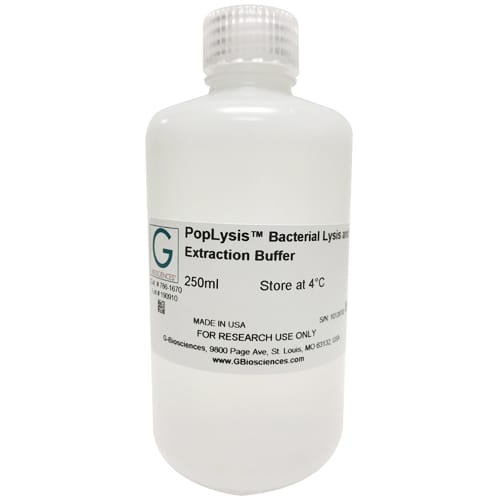 Proteomes can be made up of more 15,000-20,000 different protein species that differ greatly in properties such as molecular mass, charge, abundance, hydrophobicity and other characteristics. Extraction of proteome for analysis is therefore a daunting task that requires careful attention to details. Sample preparation for proteome analysis requires solubilization of proteins. The choice of optimal method for solubilization of protein mixture is critical since sample preparation affects the outcome of analysis. Usually the steps involved are homogenization, solubilization and stabilization when proteome sample is prepared from cells or tissues.
Proteomes can be made up of more 15,000-20,000 different protein species that differ greatly in properties such as molecular mass, charge, abundance, hydrophobicity and other characteristics. Extraction of proteome for analysis is therefore a daunting task that requires careful attention to details. Sample preparation for proteome analysis requires solubilization of proteins. The choice of optimal method for solubilization of protein mixture is critical since sample preparation affects the outcome of analysis. Usually the steps involved are homogenization, solubilization and stabilization when proteome sample is prepared from cells or tissues.
Solubility of proteins depends primarily on the ionizable amino acid side chains in the polypeptide chain. Proteins don’t have a normal distribution of their iso-electric points (pI), most of them have their iso-electric points at either around pH 5.5 or around pH 9.5. Since proteins are not readily soluble in buffers having pH equal to their pI. Very few proteins therefore have their isoelectric points between pH 7-pH 8, which corresponds to cellular pH. The solubilization buffer invariably contain buffer substances such as salts and additives that are what stabilize the proteins, the nature of buffer used depends on the source of proteome, objective of analysis and nature of workflow to be used afterwards.
The concentration and nature of salts play an important role in regulating solubility of proteins in a solubilization buffer. In general, at low ionic strength, solubility of proteins increases with increasing salt concentration but at higher concentrations of salt proteins tend to precipitate. The protein solubility at a given ionic strength varies with the nature of ions in solution. Hofmeister series arranges some anions and cations on the bases of their ability to precipitate egg white proteins. Following are some of the key cations, anions and non-ionic compounds capable of profoundly affecting solubility of proteins. Compound towards salting-in side are chaotropes They increase entropy of aqueous solutions and brings about solubilization of proteins into the buffer.
Cations
Guanidinium < Ca+2< Mg+2 < Li+ < Na+ < K+ < NH4+
Salting-in ⇔ Salting-out
Anions
SCN- <ClO4- < NO3- < Br- < Cl- < CH3COO- <SO42- <PO43-
Apart from salts, non-polar compounds such as urea and some detergents are also used for extraction and solubilisation of proteins. Urea also acts as a potent chaotropic agent and brings about solubilisation of proteins. A urea concentration of 8M is sufficient to denature most of the proteins.
Detergents form micelles, because they are amphipathic molecules, they tend to organize themselves into micelles to acquire a state of minimum energy in aqueous solutions. A large number of detergents are available and are usually chosen after a pilot screening for a given protein. Detergents can be non-ionic, such as Nonidet® P-40 Substitute, Tween® 20, Tween® 80, Triton® X-100, Triton® X-114, Brij®-35, octyl glucosides, etc. Such detergents are usually mild detergents.
Detergents can be zwitterionic and ionic also. CHAPS, amidosulfobetaine-14 and amidosulfobetaine-16 are zwitterionic detergents. Similarly, SDS is anionic detergent and CTAB is a cationic detergent. Apart from the nature of detergent to be used, which is determined by careful screening for a given application, the detergent to protein ratio is also a critical factor and detergents are used in 2-3 fold excess of proteins.
G-Biosciences provides a range of protein extraction buffers.
FOCUS™ Extraction Buffers
- Chaotropic extraction buffers
- Six different formulations
- Application: Total protein extraction and solubilization
- Denaturing
- Optimal for proteome wide studies
PopLysis™ Protein Extraction Systems
- Optimized kits for working with bacteria, mammalian cells, yeast and insect cells
- Application: Membrane and cytoplasmic proteins are extracted
- Non-denaturing
- Enzyme assays, ELISA, activity assays and protein folding studies are possible
Protein Extraction & Lysis Buffer (PE LB™) Systems
- Mild buffer for protein extractions
- Application: release of soluble active proteins
- Non Denaturing
- Enzyme activity and protein native conformation are preserved
It is important to understand that no single buffer does protein extraction from all the samples and for all the applications, the extraction/solubilization buffer’s composition needs to be optimized for a particular application and this requires a screening with available buffers and detergent formulations based on literature survey and a knowledge about the chemistry of constituents.






